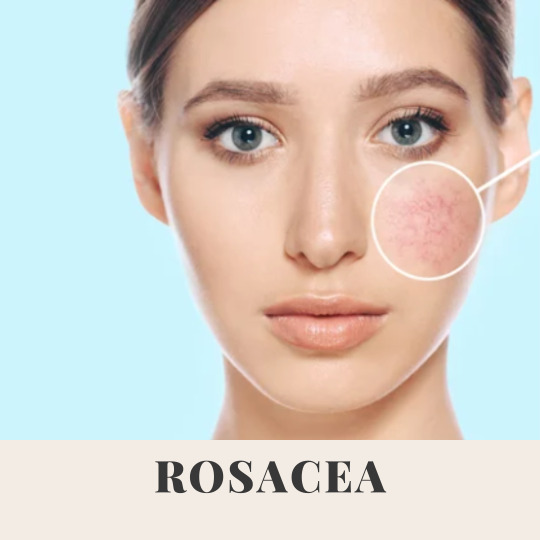Passionate dermatology blogger captivated by the world of skin health and its care. Dedicated to sharing evidence-based insights and practical tips to empower readers in their skincare journey. Join me as we explore the science and art of nurturing healthy, radiant skin together.
Don't wanna be here? Send us removal request.
Text
Unmasking the Mystery of Rosacea: Causes and Effective Treatment Options

Rosacea is a chronic skin condition that primarily affects the facial area, causing redness, visible blood vessels, and sometimes small red bumps or pimples on the skin. It is a common skin disorder that often develops slowly over time and tends to affect individuals with fair skin, although it can occur in people of any skin type.
The exact cause of rosacea is not fully understood, but it is believed to result from a combination of genetic, environmental, and vascular factors. Some common triggers that can exacerbate rosacea symptoms include exposure to sunlight, hot or spicy foods, alcohol consumption, certain skincare products, and emotional stress.
The signs and symptoms of rosacea can vary from person to person, but they often include:
Persistent facial redness: This is the hallmark symptom of rosacea and typically affects the central part of the face, including the cheeks, nose, forehead, and chin.
Visible blood vessels (telangiectasia): Small, dilated blood vessels may become visible on the surface of the skin, especially on the cheeks and nose.
Acne-like bumps: Pimple-like bumps or pustules may appear on the face. These are often referred to as papules or pustules and can be mistaken for acne.
Eye problems: Some people with rosacea experience eye symptoms such as dryness, irritation, and redness. This condition is known as ocular rosacea.
Thickening of the skin: In some cases, the skin of the nose may become thicker and develop a bumpy texture, a condition known as rhinophyma. This is more common in men.
Although there is no cure for rosacea, various treatments are available to manage its symptoms and reduce flare-ups.
Treatment options may include topical creams or gels, oral antibiotics, laser therapy to reduce visible blood vessels, and lifestyle modifications to identify and avoid triggers.
Managing rosacea often involves a personalized approach, as the triggers and severity of symptoms can vary widely among individuals. Consulting with a dermatologist or healthcare provider is essential for an accurate diagnosis and to develop an effective treatment plan tailored to one's specific needs. With proper care and management, many individuals with rosacea can successfully control their symptoms and maintain healthy-looking skin.
0 notes
Text
Soothing the Sting: Effective Remedies and Preventive Measures for Sunburn Treatment

Summer days beckon with promises of leisure, joy, and abundant sunshine. Yet, the allure of extended sun exposure can sometimes lead to the unwelcome companion of sunburn. The aftermath often includes inflamed, tender skin that radiates heat, affecting not only the typical exposed areas but also seemingly hidden spots like lips, earlobes, and the scalp. This discomfort usually emerges a few hours after the sun's embrace.
Regrettably, there exists no instant remedy to reverse the effects of sunburn once it takes hold. Once the skin is scorched, the damage is a reality that must be accepted. In the subsequent days, the body initiates its healing process, shedding the top layer of damaged skin. The timeline for recovery can vary, with more severe burns requiring several days for visible improvement.
Finding Relief from Sunburn: Soothing Strategies to Ease Discomfort
Amidst the sunburn's sting, there are several steps you can take to alleviate the discomfort and facilitate the healing process:
Embrace Coolness and Moisture: Gently place cold compresses on the sunburned areas to provide immediate relief. A towel soaked in cool water can be applied to the skin multiple times a day. Alternatively, indulge in a cooling bath infused with baking soda to soothe the affected skin.
Harness the Power of Aloe Vera: Aloe vera lotion can be a soothing balm for sunburned skin. Apply it generously to the affected areas multiple times throughout the day. For an added touch of cooling comfort, consider refrigerating the lotion before use.
Hydrate with Moisturizing Cream: Opt for a moisturizing cream designed to hydrate parched skin. Gently apply this cream to the sunburned skin several times a day to lock in moisture and promote healing.
Consider Hydrocortisone Cream: Over-the-counter 1% hydrocortisone cream can help alleviate inflammation and redness associated with sunburn. Apply it to the affected areas multiple times a day for relief.
Chill Before Applying: If using creams or lotions, enhance their cooling effect by placing them in the refrigerator before application. This added coolness can further soothe the irritated skin.
Avoid Alcohol-Containing Products: Steer clear of skincare products that contain alcohol, as they can exacerbate dryness and discomfort, prolonging the healing process.
By adhering to these proactive measures, you can provide your sunburned skin with the care it needs, promoting healing and minimizing discomfort.
Leave blisters alone
Don't break blisters if they develop. By doing this, the healing process is just slowed and the chance of infection is raised. Apply gauze sparingly over blisters if necessary.
Take an over-the-counter pain reliever
Take anti-inflammatory drugs, such as aspirin or ibuprofen, as directed on the label, as needed, to reduce swelling and discomfort. Give no aspirin to kids or teenagers. Reye's syndrome, an uncommon but potentially lethal condition, could be brought on by it.
Treat peeling skin gently
The impacted area may start to peel after a few days. This is merely your body's method of removing the top layer of unhealthy skin. Use hydrating cream even while your skin is flaking.
Drink extra water
This helps prevent dehydration.
If your sunburn leaves a huge area of your body covered in blisters, if it is accompanied by a high temperature or excruciating pain, or if it is severe and doesn't start to cure within a few days, consult your medical team.
Apply sunscreen liberally and frequently to avoid becoming sunburned again. Choose a broad-spectrum product with at least a 15-sun protection factor that offers defence against ultraviolet A and B rays.
If you use medications that increase your risk of sunburn, use caution when out in the sun. Tetracycline used orally to treat acne is a frequent illustration. Finally, when outdoors, employ common sense. Cover up and spend as much time as you can in the shade.
0 notes
Text
Chemical Peels: An Expert Method for Beautiful Skin
A chemical peel is a type of cosmetic skin treatment that involves applying a chemical solution to the face, neck or hands to improve its overall appearance. It is a popular and effective way to reduce wrinkles, age spots, acne scars and sun damage and make the skin smoother and brighter.
Chemical peels remove the top layer of skin, making the underlying layers tighter and smoother. They also aid in promoting the development of new skin cells. The type of solution used and the strength of the scrub depend on the desired result and the skin condition being treated. The procedure can take from 10 minutes to an hour and usually requires 3-5 days of recovery.

Types of Chemical Peels
Superficial chemical peels are safe and effective for all skin types and shades. If you have uneven skin, blemishes, fine lines, sun damage and blemished skin, a superficial chemical peel can help.
A medium chemical peel can cure uneven skin tone, deeper wrinkles, and acne scars.
Deep peeling that completely eliminates the damaged skin cells from the middle layer of the skin; these peels frequently use phenol or trichloroacetic acid.
What Results Can You Expect?
Chemical peeling is a popular cosmetic procedure that can help improve the texture, appearance, and overall health of your skin.
A. Immediate Results
Immediate results from chemical peels include a smoother, brighter complexion, as well as a decrease in fine lines, wrinkles, and other signs of aging. Over time, your skin will become more even in tone and texture, and the effects of the peel will be cumulative, helping to maintain a more youthful complexion.
B. Long-Term Results
Long-term results can also include a decrease in the appearance of age spots, discoloration, and other skin imperfections, allowing you to look and feel your best.
Benefits of Choosing Professional Treatment
Chemical peels exfoliate the surface layer of the skin, open pores and stimulate the growth of new skin cells. All this leads to several advantages, including:
Improves the appearance of wrinkles and fine lines
Acne treatment
Correcting pigmentation problems
Final Thoughts
Chemical peels are a highly effective cosmetic treatment that improves the appearance of fine lines and wrinkles, acne and pigmentation problems, leaving skin brighter, smoother and more youthful. They also play an important role in maintaining the overall health and beauty of the skin.
However, it is important to remember that chemical peels should only be done by a professional, as they can cause damage if not done correctly.
Join our dermatology and cosmetology conference, which is being hosted in Thailand's capital city of Bangkok, to see qualified professionals exhibit live chemical peeling techniques. Get started by contacting us!
#dermatology#dermatologist#skincaretips#laser hair removal#healthyskin#skin care#webinar#bangkok thailand
1 note
·
View note